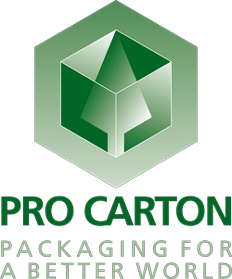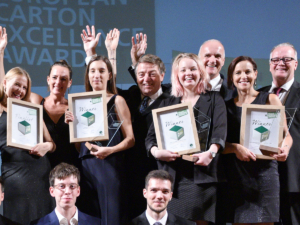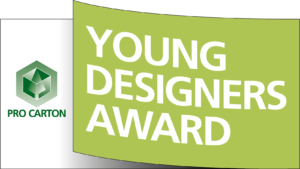Professor Giovanni Corsaro has been in the creative design industry for over 40 years and is still curious about what will happen tomorrow in terms of design, creativity, sustainability and innovation. Right from the start, his students have participated year after year in the Pro Carton Young Designers Award – and with great success. He is convinced that the future of design holds exciting changes.
Me about myself
My job has always been a balancing act between being self-employed and teaching at the “Graphische” (the Viennese Graphic Design School), responsible for advertising and package design. This has led me to meet with the most diverse people, personalities and solutions to problems. My focus has always been on the outcome of my work – and not on my person. All the prizes and awards I have won belong to the past. What counts is tomorrow: “How do I solve the given task in order to achieve the best possible outcome?” Thinking something different and being curious about “what might be around the next corner” are what drive me to look to a positive future.
Giovanni Corsaro in the midst of winners and finalists of the Pro Carton Young Designers Award.
As a creative director and designer with many years of experience in the creative industry, how has the role of packaging and packaging design evolved?
Package design as a classic protective wrapping or embellishment of the product was yesterday. What counts today is a great knowledge of materials as well as what impact the design will have on the customer. Circular design is certainly an essential factor for the future. Today’s state-of-the-art technologies, together with innovative material inventions such as sugar cane, natural sponges, recycled environmental products (e.g. fishing nets), mark the beginning of a new environmental awareness in the packaging industry. With continuous collaboration between producers, designers and customers, this leads to an improvement for the environment with cost savings and acceptance. After product content, package design is the biggest factor in determining whether the product sells and is accepted. It has to sell on its own from the shelf, even before the advertising that promotes and publicises it.
How did you get into teaching at the “Graphische” in Vienna?
One day, in the mid-1980s, the doorbell rang at my agency and one of my favourite professors at the Graphische, Hans Hoffmann, asked me if I would be interested in teaching at the Graphische. Why me? His answer: We need people like you who are successful in the industry, with a spirit of innovation, who are in daily contact with the business world and win creative awards. It took about three years until he convinced me to do it. Today, I enjoy being in constant contact with young people.
What motivates you to teach packaging design and what are the challenges of design education?
For me, teaching package design means teaching students that they have an important function and activity to do something good and right for society and the environment. In the coming years, package design will be an important cornerstone in how we use our planet’s resources properly. Just as digitalisation is taken for granted today, package design will take a fixed place as a problem solver. Good package design must stand out from the crowd through its form, material, appearance and concept, and on top of that it should not be expensive. There have been some nice examples recently where producers and designers have a shared basic belief of how it can be done.
How did you first come across Pro Carton and the Pro Carton Young Designers Award?
It was a few years ago when I first heard about it. My first thought was, “ok, they want to move away from the classic carton box and redefine innovative use of the material”. This has come true over the years and there are fantastic results today where you can see how comprehensively the students have thought about it. It’s a pity that there is not a lot of courage in industrial practice. I would like to see more of that, just like the car industry, for example, which has recently been purporting – from one day to the next – that e-mobility is a matter of course. The world belongs to the brave! Start-ups could be the key to faster implementation. Scandinavia is a model region for this.
What do you like about the award and why do you think it’s important for your students to participate in such a competition?
Basically, I think competitions are a very important assignment for students. A client defines a problem to be solved, and students are tasked with solving this and then presenting their solution. Competitions are first contacts for students, giving them the opportunity to feel what the real life of a designer is like. Achievements outside of school are rewarded by thanks and acceptance, especially through trophies and prize money. The client’s open conversation or briefing is priceless and gives the project a certain importance. Presenting in front of clients is the moment for students to get their start as designers. Winning is the confirmation.
Would you recommend picking up the award as a course project? What are the benefits you experience as an educator?
During my many years as a teacher, competitions have always been among the first projects I introduce. On average, there are about eight to twelve competitions a year in “Advertising and Package Design”, our core subject. A connection to the business world is essential. Of course, basic knowledge has to be covered first. Due to the large number of competitions, we have also set up an association that takes care of handling these. This has enabled us to achieve numerous successes in national and international competitions.
What kind of role do you think competitions such as the Pro Carton Young Designers Award play in the packaging industry?
As a result of this long, successful cooperation with Pro Carton, I would like to state that this competition has changed very positively over the years – continuously aiming to provide solutions today for tomorrow. For the carton industry, a competition like this is always an advantage because you can very quickly recognise the design trends.
As you’ve been one of the longest participating teachers attending our award, are there any experiences or insights you’d like to share? Anything you’d like to say to the young designers out there? Or to the packaging industry even?
My experience is that decision makers take too much time to make decisions. As a result, innovative ideas end up being corrected too much and the original idea is lost. To the package design industry, I take the liberty of saying, “What is innovative today will be taken for granted tomorrow.” Innovation means being brave, giving design experts more opportunities and integrating this into the process as a matter of course.
Please complete the following sentences:
Good packaging design is … Good packaging design is sustainable reduction.
I’m inspired by … I’m inspired by nature.
As a young designer, I would … As a young designer, I would afford a lot of education.
I choose cartonboard because … I choose cartonboard when the product needs it and is enhanced by it.





